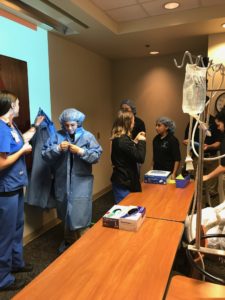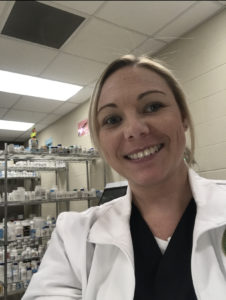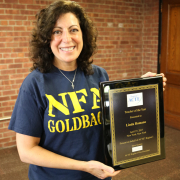Indiana HS Prepares Students for Success in Pharmacy Technology
It’s no secret: Healthcare workers are in high demand. Ten of the top 20 fastest-growing occupations nationwide are in health care; certified nursing assistants, physical therapists and nurse practitioners are among the most sought-after (United States Department of Labor, 2018).
Across the country, CTE instructors are doing great things in the classroom to prepare students for in-demand careers. They’re collaborating with industry and workforce development representatives; they’re securing certification opportunities; and they’re providing unique hands-on learning experiences that engage today’s youth in high-demand, high-skilled, high-paying jobs. The pharmacy technician program at the Area 31 Career Center at Ben Davis High School in Indianapolis, Indiana, is one such example.
Student engagement at work
“Indiana has put a tremendous focus on developing partnerships between secondary and postsecondary and industry, and it is those partnerships that have enabled us to create programs that meet industry demand,” said Patrick Biggerstaff, director of career and technical & adult education and Area 31 Career Center Programs at Ben Davis High School and past president of Indiana ACTE. “Early college pathway programs like these give students the chance to develop employability skills and knowledge, understand the opportunities available to them, and earn credentials that move them to the head of the pack when applying for jobs.”
The Early College Career Center was established as a partnership between Vincennes University and Wayne Township to address those industry needs. The career center not only gives students the opportunity to earn a high school diploma as they learn industry-needed skills but, as of four years ago, offers associate degrees in pharmacy technology (and also in culinary arts, precision machining and aviation maintenance).
According to the U.S. Department of Labor, demand for pharmacy technicians is growing more than 10 percent faster than demands for other occupations (United States Department of Labor, 2018). In Indiana, local job opportunities reflect that trend.

“The pharmacy technician program is a high-value program in this state, and our community partners understand that,” said Biggerstaff. “They see the need to develop this pipeline of their future workforce and make sure they’re invested so they, too, can help guide decisions and curriculum needs to make sure we’re aligned with industry needs and preferences.”
Those community partners include Walgreens, CVS and local hospitals, which support the program by conducting mock interviews, guest teaching, offering job shadowing opportunities, and providing financial support for student exams and study materials. Pharmacy technician students are also able to experience classroom and simulated lab activities, hospital and retail practicum experiences; in the nation’s only high school lab accredited by the American Society of Health-System Pharmacists, students gain further advantage in the eyes of potential employers, such as IU Health West Hospital in Indianapolis.
Real-world, on-the-job training
Students from 11 high schools in three Indiana counties come to the career center to take courses during the regular school day. In 2018, the program recognized its second cohort of high school students graduating with associate degrees. According to Jessica Lamb, pharmacy tech instructor, these students are often “direct admits” to pharmacy schools — meaning they will bypass the need to complete general education credits before applying for admission to the major.

“These students can use their degrees as stepping stones for a lot of different career paths, and they’re leaving high school with a vast majority of college finished,” said Lamb. “In the meantime, people from local businesses are knocking down our doors asking for these students. The last six who worked in a local long-term care facility were offered jobs — all six.”
Offers like that reveal the necessity of programs like these, which combine classroom learning experiences with real-world, on-the-job training opportunities. At the Area 31 Career Center, students spend the first year in the classroom and the second year developing clinical experience.
Local and regional partnerships ensure that students receive credible, industry-relevant learning opportunities: Area pharmacists run labs and practice scenarios, while local employers often host mock interviews and teach lessons. Each student in the cohort has the chance to participate in work-based learning opportunities, like those coordinated each year at IU Health West Hospital.
“They conduct actual simulations as though they were in an in-patient or retail pharmacy,” said Amy Hurst, pharmacy technician supervisor at IU Health West Hospital. “They play the role of pharmacist, technician; they simulate sterile compounding… They get to understand the reality of being a pharmacy technician.”
According to Hurst, such experiences are valuable not only for the practical, hands-on job training opportunities they provide but for the excitement and interest they generate.
“Once the students see and experience for themselves what goes into being a pharmacy technician, they get excited and start asking questions. You can see the light bulbs go off,” she said. “That connection is what’s important. These kids are the future of pharmacy.”
A March 2018 report by the U.S. Chamber of Commerce Foundation and Burning Glass Technologies showed increasing gaps between employer needs and available workers; in fact, unfilled health care occupations represented the most “dramatically expanding” skills gap in their research (Restuccia, 2018, p. 12). By engaging students with relevant, real-world learning opportunities in addition to addressing academic and employability skills, CTE programs like the one at Area 31 Career Center at Ben Davis High School can help address those gaps.
“One of the challenges right now, across our country, is looking at how best to address the skills gap and workforce demand going forward,” said Biggerstaff. “There’s so much data out there showing that secondary CTE programs are meeting needs and engaging high school students in ways that are meaningful and helping to change their life trajectories.”
Emily Kuhn is the communications specialist for Realityworks, Inc, a Wisconsin-based company that creates innovative learning tools for skills training.

